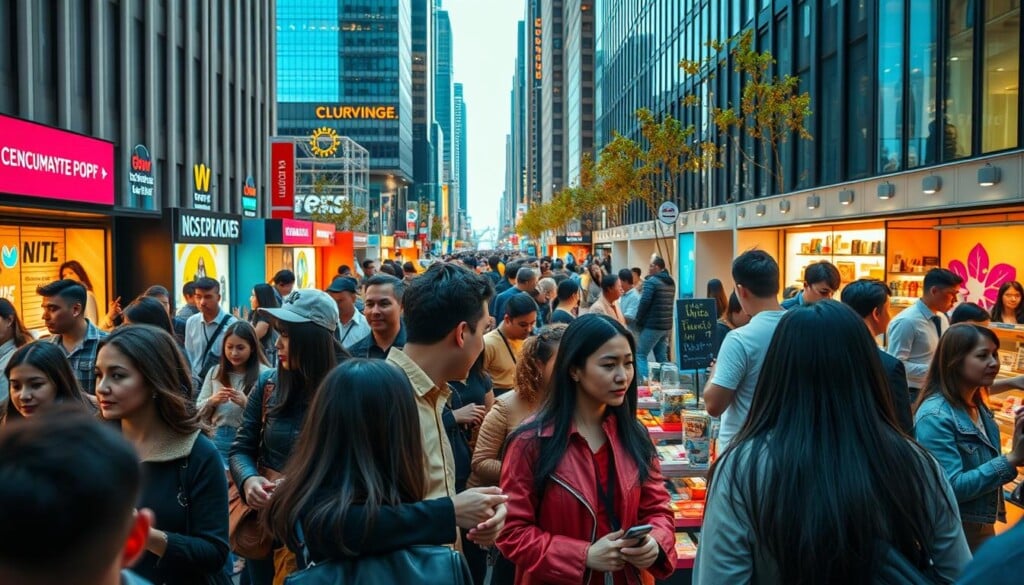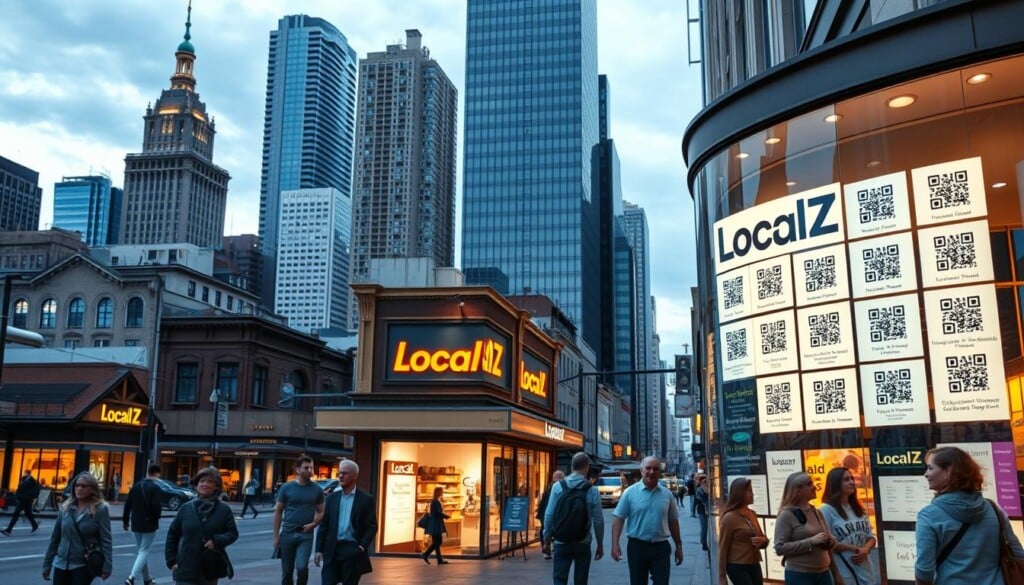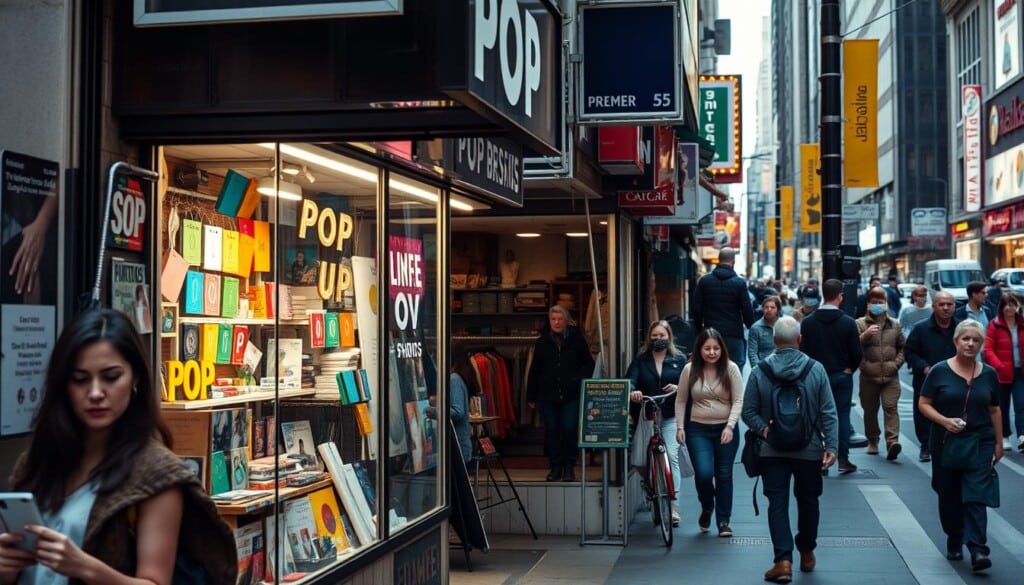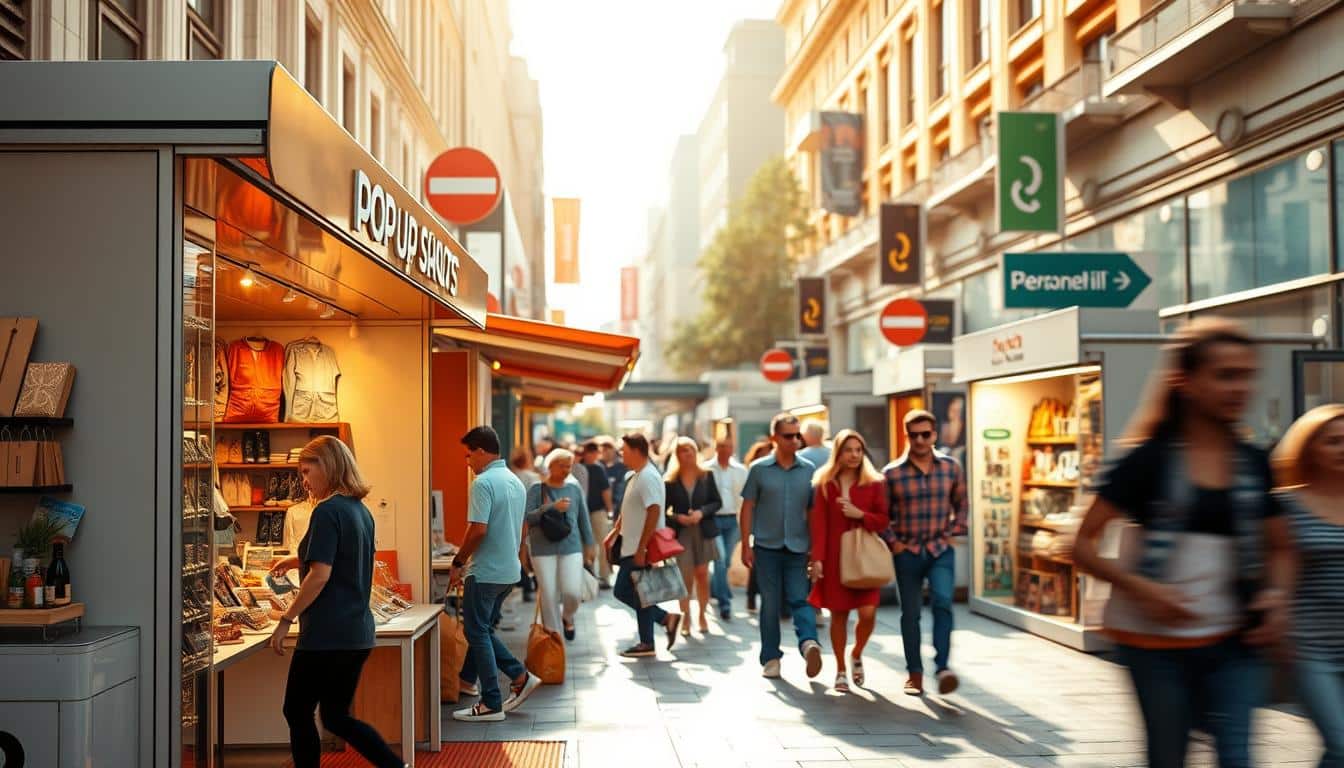Why do brands like Glossier and Casper keep gaining traction with consumers amidst the retail chaos? The answer lies in the innovative strategy of pop-up shops. These temporary retail environments serve as dynamic brand activations. They offer companies the chance to engage customers through immersive experiences.
As traditional retail encounters evolving consumer behaviors, experiential marketing through pop-up shops has emerged as a powerful mechanism. It drives sales and strengthens brand presence. This article explores the multifaceted significance of pop-up shops. We’ll dive into their history, benefits, and execution strategies in the modern retail landscape.
Key Takeaways
- Pop-Up Shops are defined as temporary retail spaces.
- They foster brand engagement without long-term lease commitments.
- Experiential marketing is a cornerstone of successful pop-up strategies.
- Temporary retail can significantly boost brand visibility and sales.
- Pop-Up Shops connect brands and consumers face-to-face.
- Understanding the dynamics of local markets enhances pop-up success.
What Are Pop-Up Shops?
Pop-up shops are temporary retail spots that let brands connect directly with customers. They offer a unique way to engage with people through hands-on experiences. This approach allows businesses to showcase their products in a real-world setting.
Definition and Purpose
The main goal of pop-up shops is to grab people’s attention and boost sales. They create a fun shopping experience that customers remember. These shops use creative designs to draw in visitors and build excitement for the brand.
History and Evolution
Pop-up shops started in the early 2000s in cities, helping brands enter new markets cheaply. Over time, they’ve become a flexible strategy for brands all year round. Now, they help brands reach different people and boost their visibility.
Key Benefits for Retailers
Pop-up shops save money on operations compared to regular stores. They also let brands get quick feedback from customers. These shops offer unique experiences, making them a great way for businesses to test products and gather data.
The Rising Popularity of Pop-Up Shops
Recently, pop-up shops have become a big hit in marketing. Brands are focusing on creating memorable experiences for their customers. This approach meets the demand for unique and personal shopping experiences.
Trends in Consumer Behavior
Today, people want shopping that’s special and tailored to them. Studies show 81% of shoppers prefer brands that offer custom experiences. Pop-up shops help create these experiences, making customers happy and loyal.
Seasonal and Temporary Appeals
Seasonal pop-up shops create buzz with their limited-time offers. They attract customers during certain times, boosting sales and foot traffic. The sense of urgency encourages people to buy, making these events successful.
Impact of E-commerce on Pop-Ups
E-commerce has changed how pop-up shops work. It allows brands to blend online and offline experiences. Using digital marketing, shops can reach more people, making pop-up shops key in today’s retail world.

How to Launch a Successful Pop-Up Shop
To launch a pop-up shop successfully, you need a clear plan. This plan should draw in the right customers and make sure they notice and engage with your shop. Knowing your market helps you tailor your approach just right.
Identifying Your Target Market
Doing deep market research is key. It helps you understand who your customers are. You learn about their demographics, what they like, and how they shop. This knowledge lets you create experiences that really speak to them.
By getting these insights, you can offer products and services that meet their needs. This makes your shop more appealing and relevant to your audience.
Location Selection Tips
Where you set up your pop-up shop is very important. Look for places that lots of people pass by and can easily get to. A smart location strategy can really help your shop thrive.
Knowing who lives and shops nearby is also important. This helps you pick the best spot to attract more people and boost sales.
Marketing Your Pop-Up Effectively
Marketing your pop-up shop needs to be exciting and grab attention. Use social media and team up with influencers to get the word out. Also, send out emails and run ads in your area to spread the news.
Make sure your message is clear and compelling. Talk about how unique and special your event is. This will encourage people to come and make your pop-up a hit.
Integrating Locally with LocalZ
LocalZ is a key platform that connects businesses with their local communities. It helps businesses reach out to customers eager for new experiences. By using LocalZ, brands can improve their visibility and meet local engagement goals.
Connecting Businesses and Communities
Building a strong bond with the community boosts a brand’s reputation. LocalZ offers a chance for businesses to connect with locals. By promoting local products and services, businesses build valuable relationships.
Listing Your Pop-Up Shop on LocalZ
Listing pop-up shops on LocalZ makes it easy to reach local customers. The platform helps businesses share important details and ensures listings are easy to find. This makes it simpler for locals to find interesting events.
Benefits of Being Found Locally
Being listed on LocalZ can bring many benefits to brands. It attracts more people to events and builds trust in the community. Local listings also help in building long-term relationships with the community.

Maximizing Sales During Your Pop-Up Event
To boost sales at pop-up events, businesses need to engage customers well. Creating immersive experiences grabs attention and builds loyalty. This makes experiential marketing key.
Interactive elements like product trials and demonstrations keep customers involved. This strengthens the bond between the brand and its audience.
Engaging Customers Through Experience
Creating memorable moments at pop-up shops boosts satisfaction and keeps customers coming back. Brands should make unique atmospheres where customers can connect with products. This way, businesses build deeper relationships and get more repeat business.
Utilizing Social Media for Promotion
Social media is great for promoting pop-up shop events. Instagram and TikTok let brands share sneak peeks and event coverage. This creates excitement and anticipation before the event.
Offering Exclusive Deals and Products
Exclusive offers make shopping at pop-up events special. Limited-time deals create a sense of urgency, driving sales. This strategy makes customers feel valued for being part of the event.
Collaborating with Other Local Businesses
Working together with local businesses can make pop-up shops more effective. By teaming up, brands can reach more customers and offer a unique shopping experience. They can host joint events, promote each other, or share a space, all of which boost customer interaction.
Forms of Collaboration
There are many ways local businesses can work together. They can host events together, share marketing efforts, or offer special deals. This allows them to connect with their community in creative ways.
Benefits of Local Partnerships
Local collaborations bring more than just visibility. They help businesses build stronger ties within the community. By working together, they can host bigger events and improve their reputation and customer loyalty.
Case Studies of Successful Collaborations
Some pop-up collaborations have been very successful. For example, a bakery and a fashion shop working together can attract more people and appeal to different customers. These partnerships show how businesses can work together to enhance the shopping experience. Joining platforms like LocalZ can help make these collaborations even more effective.
Measuring the Success of Your Pop-Up Shop
Checking how well a pop-up shop does means looking at many things. It’s key to know what works and what doesn’t. By using sales numbers and how many people visit, brands can see if they’re doing well.
KPIs to Consider
It’s important to watch several key performance indicators (KPIs) when judging a pop-up shop. These help show how much is sold, how people interact, and what they think. Looking at how many people buy and how much they spend helps figure out what makes a pop-up successful.
Customer Feedback
Getting feedback from customers is very important. Surveys, forms, and talking directly to people can give great insights. This helps brands know what to improve on, making future events better.
Sales vs. Foot Traffic Analysis
Looking closely at sales and how many people visit can show what customers like. It helps brands see if their marketing works. By comparing sales to foot traffic, brands can make their pop-up events even better.
Challenges Faced by Pop-Up Shops
Pop-up shops face many challenges due to their short-term nature. These issues include quick marketing, planning, and efficiency problems. The short time frame makes it hard to plan and execute well.
Short-Term Nature of Operations
Pop-up shops have to work fast to market and sell. Teams struggle to get noticed and make an impact quickly. They must keep improving their plans to grab attention fast.
Logistics and Inventory Management
Planning logistics is key for pop-up success. Managing inventory is critical to avoid running out of stock or having too much. Brands need to guess sales and foot traffic well to succeed.
Regulatory and Legal Considerations
Pop-up shops must follow many laws and rules. They need permits and to know local zoning laws. Not following these can lead to fines or problems that slow them down.

Future of Pop-Up Shops
The retail world is changing fast, and pop-ups are looking good. Experts say we’ll see more creative ways to connect with customers. Brands will aim to create unique experiences that match what people want.
These pop-up shops will draw in more people. They’ll also help brands build stronger bonds with their customers.
Predictions for the Retail Landscape
Pop-up shops are set to become key for brands. They’ll focus on making each visit special for customers. This will help them stand out in a crowded market.
People want to remember their shopping experiences. Pop-ups will play a big role in making those memories.
Sustainability Practices
Pop-up shops will need to be green to succeed. With more people caring about the planet, brands must show they care too. They’ll use eco-friendly materials and sustainable ways to source them.
This will help brands connect with customers who value the environment.
Technological Innovations in Retail
New tech will change how pop-up shops work. We’ll see things like augmented reality and smart checkout systems. These tools will make shopping better and give brands useful insights.
Join LocalZ Today and Elevate Your Brand
Getting your business noticed in your local area is now easier than ever. LocalZ makes it simple to register your business. This way, you can quickly reach out to your target audience and boost your brand’s image.
LocalZ helps local businesses by giving 50% of its annual fees to community groups. This helps build strong ties within the community. It also offers chances for funding that can help your business grow. Working with community affiliates shows your dedication to supporting local businesses.
Using LocalZ lets you connect with local customers right away. This digital tool improves customer experience and builds loyalty. Join LocalZ today to grow your brand in the local market and give back to your community.

